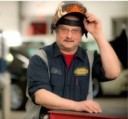The Story of Detroit Electric

In 1907, the William C. Anderson Carriage Company, builder of carriages and buggies since 1884, morphed into the Detroit-based Anderson Electric Car Company. The company manufactured some 13,000 Detroit Electric Cars until 1939, making it an integral part of the history of the American Car Industry.
At Service King Azure, we love automotive history, and that's why we're happy to share this with our readers in Las Vegas and all over NV.
The vehicles manufactured by Anderson Electric Cars were considered state-of-the-art in their time. These beauties were advertised as being capable of reaching speeds of 20 mph, and could go 80 miles between recharges. In one test, a Detroit Electric went just over 211 miles on a single charge. This was a huge advancement in automobile technology-- comparison to early 1900s combustion engine cars, which were dirty and unreliable, these vehicles were clean, efficient, and modern.
The Detroit Electric was powered by a rechargeable lead acid battery, but, for $600 more, an Edison nickel-iron battery could be had between 1911 and 1916.
At the time, these Detroit Electric cars were especially popular with women and doctors. Both demographics preferred cars that not only were dependent from the very start, but also could be started without having to crank the engine, as was the case with the early combustion engine models.
 The refined car was designed to make a subtle statement: it certainly stood out from the usual designs of the time, as it was the first production car with curved windows, historical websites say.
The refined car was designed to make a subtle statement: it certainly stood out from the usual designs of the time, as it was the first production car with curved windows, historical websites say.
At its peak production in the 1910s, the company sold up to 2,000 cars per year. The high price of gasoline during World War I aided sales as well. In 1920, the car-producing side of the company adopted the name "The Detroit Electric Car Company", while the body side of the business joined Murray Body.
The brand had some famous fans, including Thomas Edison, Mamie Eisenhower, Charles Proteus Steinmetz, and John D. Rockefeller, Jr., as well as Henry Ford’s wife Clara Ford, who drove Detroit Electrics for several years.
Electric car sales slumped in the 1920s, as internal combustion engines improved, multiplied and got less expensive, but the company stayed afloat. It wasn't until after the stock market crash of 1929 that the company filed for bankruptcy. Soon after, the firm was purchased and continued scaled-back operations building special order cars for several years.
The last Detroit Electric was shipped on February 23, 1939.
Examples of these historic cars can be found in various museums, including the Belgian Autoworld Museum in Brussels, The Henry Ford Museum in Dearborn, Michigan and Germany’s Museum Autovision. A restored and operational Detroit Electric is currently on loan to the Edison Tech Center in Schenectady, NY, from Union College.
Today, yet another chapter in the story of the Detroit Electric is in the works, as combustion engine vehicles begin to fall from favor, according to the company’s website.
“Our vision at Detroit Electric is to change the way people choose their products and services through electric technology, one invention at a time,” their site says.
The Detroit Electric brand was resurrected some five years ago by CEO Albert Lam, who says “excitement is building at the heart of Detroit Electric once again,”. A Detroit Electric factory in the UK is presently laying the foundation for becoming a major player in the electric car-making industry, though they’re still some distance away from launching manufacturing operations.
Sources; Wikipedia , Detroit-electric-group.com, Cleantechnica.com









 The refined car was designed to make a subtle statement: it certainly stood out from the usual designs of the time, as it was the first production car with curved windows, historical websites say.
The refined car was designed to make a subtle statement: it certainly stood out from the usual designs of the time, as it was the first production car with curved windows, historical websites say.
Social